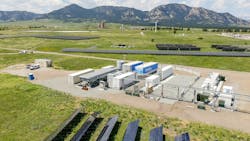NASA, in Partnership with NREL, Selects Tweed New Haven Airport (HVN) for Airports as Energy Nodes (ÆNodes) Activity
Avports announced that the National Aeronautics and Space Administration (NASA), in partnership with the National Renewable Energy Laboratory (NREL), selected Tweed New Haven Airport (HVN) as the first FAA Part 139 certified commercial airport in the United States to join the “Airport as Energy Nodes (ÆNodes)” activity. Avports, as airport manager and operator, submitted the proposal to partner with NREL and NASA on ÆNodes on behalf of the Tweed New Haven Airport Authority (TNHAA), the airport sponsor.
ÆNodes is an activity within the Convergent Aeronautics Solutions Project of NASA’s Aeronautics Research Mission Directorate in collaboration with NREL to research how airports can provide the right form and quantity of energy needed for future aviation operations in scalable, affordable, and sustainable value to aviation and community stakeholders.
With the dawning of zero-emission aviation, advanced/regional air mobility, and the electrification of vehicles, including conventional aircraft and electric Vertical Take-Off and Landing (eVTOL) air taxis, airports will require alternative energy forms while establishing the airport as a desirable component of the community energy solution. “Planning for the energy needs of an airport is challenging, and we see this program as an opportunity to understand how to implement a more sustainable future,” says Tom Rafter, Executive Director of TNHAA.
“The goal is to develop robust solutions to an uncertain future mix of vehicles/energy needs and types, provide lasting community value, and enable investment pathways that accelerate adoption,” says Nick Borer, the Principal Investigator of ÆNodes at NASA. “Our objective is to work with NREL and regional airports such as HVN to generate data, reports, and designs of future airport energy architectures for full-scale development and demonstration.”
HVN is a regional airport in Southern Connecticut managed and operated by Avports. The airport is developing a new passenger terminal and is committed to delivering a zero-emissions future operation.
HVN New Passenger Terminal Image
"At Avports, we are dedicated to electric aviation readiness. By partnering with TNHAA and NASA/NREL at HVN, we are identifying necessary infrastructure, evaluating current vertical flight operations, ensuring robust power capacity and resiliency, enhancing customer experience, and addressing the airport's community needs. Our goal at Avports is to make electric aviation a feasible and sustainable reality," Jorge Roberts, CEO of Avports.
Integral in ÆNodes is NREL, which will develop an energy virtual twin of the airport and validate it using NREL’s Advanced Research on Integrated Energy Systems (ARIES) platform. Those capabilities will enable a team of NREL researchers to evaluate Tweed HVN’s current and future operations and energy needs, examine energy harvesting and fuel cycles for air and ground assets, and model shared airport–utility interaction for normal and emergency scenarios.
“NREL’s modeling and simulation capabilities will allow us to examine a multitude of future operational scenarios for HVN,” says NREL sustainable aviation researcher Nick Grue. “For example, if the airport deploys new technologies—like electric heat pumps for buildings or charging infrastructure for future electric aircraft and ground vehicles—how will that affect its electrical requirements? Could onsite renewable generation help offset an increase in demand? We’ll be able to answer those questions and others in detail so the airport can plan ahead.”
“As CEO of the Avports New HVN team, and on behalf of the TNHAA, we are delighted to be part of the project and believe that this program will facilitate not only our airport but also airports around the US to enable a more sustainable aviation future,” says Michael Jones.
ÆNodes research will be conducted over the next two years, and the plan is to share the findings as appropriate with the whole community to advance the future of aviation.

